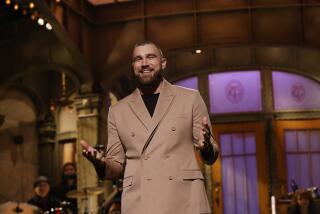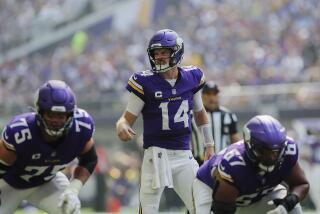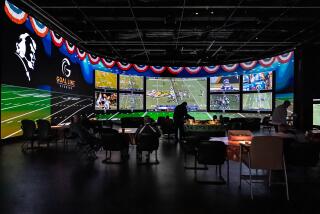Peyton Manningās road back to the top
ENGLEWOOD, Colo. ā All Peyton Manning wanted was a haircut. Somewhere between his Denver home and the barber, he got lost.
Thatās right, the NFLās premier traffic cop on the field, a guy who does commercials for cars that talk back to him, had to call his wife for directions. Mr. Manning was Mr. Magoo.
āIām calling Ashley all the time, āNow, how do I get here again?āā he said. āSheās got an unbelievable sense of direction. I donāt.ā
The Indianapolis transplant, now star quarterback for the Broncos, eventually reached his destination ā and found a bright side.
āThose reminders are good,ā said Manning, 36. āYouāre in a new place. Letās keep working hard. Take it slow.ā
The Broncos arenāt taking it slow. Theyāre rolling with their new quarterback, winners of five in a row with a three-game lead in the AFC West. Manning has the AFCās most passing touchdowns, 24, best completion rate, 68.5%, and top passer rating, 106.2.
The leagueās only four-time most valuable player, who sat out the entire 2011 season recovering from four neck procedures, is on course for MVP No. 5.
āWhat Peyton is doing, in my brain, is not just remarkable, itās freaking historical,ā Broncos Coach John Fox said. āTo be where he is, off of what he just went through. Just look at it, his life got turned upside down.
āHeās been in one place for 14 years, and he never imagined heād be anywhere else. To have a real serious injury, where at one point you werenāt real sure you were ever going to throw again. To be where he is right now? Heās doing it in a completely different part of the country, with a completely different organization. Iām loving it, but I think about it and Iām like, āThis is kind of bizarre.āā
Manning, standing with a reporter in an otherwise empty corridor outside the locker room at the practice facility, detailed his improbable and sometimes uncertain ascent back to the top of the game, and the help he received from an old friend.
That friend was Duke Coach David Cutcliffe, who was Manningās offensive coordinator at Tennessee and his younger brother Eliās head coach at Mississippi. Cutcliffe, who a year earlier had worked with Eli during the lockout, was Peytonās coach of choice during his arduous comeback.
āGoing to a private college, where the gates are locked, thereās no spectators, and you can get concentrated work, that was big for me,ā said Peyton, who had made at least four trips to Duke last winter before the media caught wind of it.
Manning lived with the Cutcliffe family during those visits. Just another kid in the stately, lodge-like house, with his own room and a pile of laundry every day.
āHe and I both really got to go back in time,ā Manning said. āI was a junior in college again. He was my coach. He coached the hell out of me. He yelled at me. āFaster! Faster! Faster!ā I can remember that same feeling I had in college. Iād get mad at him.
āWeād go at it. It would be intense. But Iād always caught a ride home to his house that night, had dinner with him, and spent the night at his house. So we couldnāt get too mad at each other.ā
Cutcliffe, who speaks in a rich Southern drawl, calls himself a ādrills maniacā and says that stems from his childhood in Alabama, when he would throw his way through a pasture by ācompletingā passes to specific limbs of trees.
He had Manning do all the traditional drills, and some different ones, such as Manning making precise throws while equipment managers hammered away at him with heavy bags.
āWe call those distraction drills,ā Cutcliffe said. āOne of the more critical things for a quarterback to prove to you is that his eyes stay downfield. Weāre making him make decisions. Weāll have two targets down there and weāll immediately try to lean toward one of them and make him make an accurate throw to the other target. At the same time, heās got big bags being thrown down at his hips, legs, across his face. But you know heās keeping his eyes downfield.ā
For Manning, the process was grueling. It wasnāt just drills, but near-constant work on his strength, conditioning, flexibility, nutrition ā¦ everything. There were no guarantees heād be able to return.
āNobody knew, including me, how this would play out,ā he said. āI couldnāt find anybody else who had the same injury. There was no model. [Former NFL safety] John Lynch said he kind of had something like it, but he can blow up guys with a bad, weaker arm. [Former NFL quarterbacks] Chris Weinke and Brad Johnson kind of had something like it, but it wasnāt quite the same. So even these doctors, these respectable doctors, the top neuro guys in the world, are going, āI donāt know. Itās kind of hard to say. Nerves are unpredictable.ā Thatās kind of what I had to go on.ā
Manningās progress was measured in millimeters, not miles.
āItās been the biggest physical and mental challenge Iāve gone through, as far as a test of patience,ā he said. āIām talking about progress that literally [pinching his fingers to indicate a tiny bit] where a good month is thereās no setbacks. There was no significant weight-room increase. And itās still that way. I could go to the weight room right now and show you.
āWhat Iāve learned to do is compensate. Thatās what athletes do. You learn to compensate with what youāve got.ā
He likened that to a golfer who might not be able to hit a three-wood as far anymore but instead lays up with an iron and relies on his precision to make birdie.
āIāve come to accept the reality that I am 36 years old,ā he said. āIām not trying to be the player that I was when I was 28. Iām not. I donāt compare myself to that.
āAt our college camp [the Manning Passing Academy] this summer, these kids, theyāve got some arms. This kid from Georgia, Aaron Murray, he can throw it a mile. All these kids. Six years ago, Iād have said, āHey, Iām going to out-throw all these guys.ā But now, these kids can throw it farther, and it has zero effect on my psyche. Iām 36 years old, Iām coming off a major injury, and my arm has a lot of miles on it.
āI can still get them in the end zone doing it a different way, dinking and dunking, taking my shots at certain times. So Iāve learned a lot about my body, and about my team.ā
Cutcliffeās final test was incredibly elaborate. The coach wanted to make sure Manning was able to make all the throws necessary to win an NFL game. So he meticulously broke down every element of the Coltsā 30-17 victory over the New York Jets in the 2009 AFC championship game ā then completely re-created a seven-on-seven version of that game.
To make the simulation as realistic as possible, Cutcliffe brought in Tom Moore, Manningās offensive coordinator in Indianapolis, and some of the players who No. 18 knows best ā center Jeff Saturday, tight end Dallas Clark and receiver Brandon Stokley. Filling the other spots were former Duke players, and even some equipment managers.
āWe took every play and the Coltsā script,ā Cutcliffe said. āThen we took the Jetsā offense and timed how long they were on the field and what they accomplished. So Peyton would go to the sideline and sit on the bench and Iād say, āAll right, itās third down.ā Heād get up and jogged a little bit. Heād throw to loosen up. Then weād have a punt or whatever.
āHeād head out there, and he knew that weāre trying to throw it in 2.7 seconds. Hereās the receiver and hereās the play. We had one of our running backs whoād finished his eligibility, and we ran the play when it was a run. We even made it so if a guy dropped the ball in the real game, heād drop the ball in the fabricated game.ā
Afterward, Manning and Cutcliffe studied the video of the simulation and determined he was able to make every throw needed to win a playoff game. The Colts had yet to release him, but he knew that he would be ready to play this season.
āThe appreciation for me was reliving the intensity of a man willing to work beyond what any human can push themselves,ā Cutcliffe said. āIt was an incredible thing. I wish now ā and he agrees with me ā that we had let somebody come in to document that. Because I donāt know if anybody else could have done it.ā
Even though most everyone expected the Colts to release Manning and use the No. 1 pick on Stanfordās Andrew Luck, the finality of it still left Manning stunned.
That was evident when he first met with Broncos executive John Elway a couple of days after he was released.
āHe was still in shock when he got here,ā Elway said. āThatās when I told him, āPeyton, you can take these trips and visit. But you need to just take your time and not rush into anything. You need to get your arms around whatās happened. Then you can take the next step.ā
āWe went to dinner over at Cherry Hills [Country Club]. Weāre sitting on the sofa talking, and I just told him, āI understand.ā He was just saying, āEveryoneās telling me, my wifeās telling me, itās in the paper. I know it. But it still shocks me.ā And you could tell. But I think thatās the mind-set of great players. Thereās no way you can let it go.ā
The Broncos saw him throw and were satisfied. They were one of three teams that were finalists to land him, the others being San Francisco and Tennessee.
Manning said his top concern was actually being the player those team owners ā Denverās Pat Bowlen, Tennesseeās Bud Adams and San Franciscoās John York ā expected to get.
āWhen you sign with a team, when I met with Mr. Bowlen and he said, āI want you here,ā same way when I met with Bud Adams, or when I met with York in San Francisco, I feel that responsibility to be the player they wanted,ā he said.
The Broncos couldnāt ask for more. Manning is a coachās dream. He doesnāt waste a moment, whether itās during practice, in the meeting rooms, on the road, wherever.
āHe writes down everything,ā Fox said. āHe writes down my Wednesday talks to the team, and then Iāll hear it again with the media. Iāll hear it again when he talks to his teammates, at the end of practice. Itās off-the-chain leadership.
āHe holds guys accountable, man. They donāt want to let him down.ā
Whatās more, Manning wants to know everything thatās going on in the organization. He wants to know where the college scouts are headed and why. Wants to know who that person is on the sideline, and whether he really needs to be there. Heās half player, half coach, and seemingly all knowing.
āIf he werenāt a great player and you were a player on his team, heād be a pain in the butt,ā Hall of Fame coach John Madden said with a laugh. āBecause he never wants to leave you alone.
āIf youāre an offensive player and itās a defensive period, they go over and stand on the sideline and B.S. Peyton wonāt let them do that. Heāll grab a guy and go down on the 10-yard line and work there. He just goes the whole time. āNow remember this: When we donāt huddle, Iāll give you the signal, and theyāre going to do thisā¦ā Itās constant for him. Heās seeking perfection. The only way heās going to get close to that is when everyone else is striving for perfection and getting close to it.ā
The Broncos players have embraced that. They appreciate Manningās relentless pursuit of precision and perfection, and the results reflect that.
āFrom day one when he got here, there was a certain way he wanted to do things,ā receiver Eric Decker said. āIf you wanted to be great, you had to be willing to do that. Thatās the thing thatās so special about him, is his work ethic. Weāre always talking about a route that we see, or a coverage that weāre going to go against. Itās always football.ā
The way Madden sees it, weāve gotten only a glimpse of how good Manning can be ā that heāll be even better in the coming weeks.
āIāve been watching him and saying, this guy is going to get better,ā Madden said. āHeās not going to be Peyton until after the midway point of the season. I think heās getting close to being comfortable. And itās very important to Peyton that heās comfortable.
āIāll text back and forth with him once in a while. Iāll say, āYouāre better this week than you were.ā And you can just see the progression. I think everyone is going to the neck and the health and the arm strength. But with Peyton itās about perfection. Everything has to be perfect. From the calls, the other players understanding, to what he can do to help himself, to what he can do to help his team.ā
But heās not the same player he was in Indianapolis. He has adapted and grown. Like that meandering trip to the haircut, heās blazing a new path in Chapter 2 of his career.
āIām a different quarterback,ā he said. āIāve got these two unbelievable kids now. My life has just totally changed. Iāve changed with it. Iām learning to live with something every day.ā
Twitter: @LATimesfarmer
More to Read
Go beyond the scoreboard
Get the latest on L.A.'s teams in the daily Sports Report newsletter.
You may occasionally receive promotional content from the Los Angeles Times.











